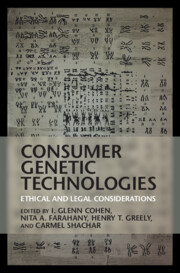Book contents
- Consumer Genetic Technologies
- Consumer Genetic Technologies
- Copyright page
- Contents
- Contributors
- Acknowledgments
- Introduction
- Part I Consumer Genetic Technologies: Rights, Liabilities, and Other Obligations
- Part II Privacy in the Age of Consumer Genetics
- Part III Tinkering with Ourselves: The Law and Ethics of DIY Genomics
- Introduction to Part III
- 10 Programming Our Genomes, Programming Ourselves
- 11 Governing Nontraditional Gene Editing
- 12 Finding a Regulatory Balance for Genetic Biohacking
- Part IV Consumer Genetics and Identity
- Part V The Impact of Genetic Information
12 - Finding a Regulatory Balance for Genetic Biohacking
from Part III - Tinkering with Ourselves: The Law and Ethics of DIY Genomics
Published online by Cambridge University Press: 27 August 2021
- Consumer Genetic Technologies
- Consumer Genetic Technologies
- Copyright page
- Contents
- Contributors
- Acknowledgments
- Introduction
- Part I Consumer Genetic Technologies: Rights, Liabilities, and Other Obligations
- Part II Privacy in the Age of Consumer Genetics
- Part III Tinkering with Ourselves: The Law and Ethics of DIY Genomics
- Introduction to Part III
- 10 Programming Our Genomes, Programming Ourselves
- 11 Governing Nontraditional Gene Editing
- 12 Finding a Regulatory Balance for Genetic Biohacking
- Part IV Consumer Genetics and Identity
- Part V The Impact of Genetic Information
Summary
The rise and ease of genome-editing technologies, like CRISPR, has ushered in communities of “biohackers,” do-it-yourself enthusiasts for molecular genetics who perform experiments outside traditional institutional laboratory settings. Conventional wisdom posits that such research is beyond traditional modes of regulation or legal enforcement and that new biohacking laws are needed. This view, however, is incorrect; both public and private regulators currently possess–and in other contexts, use–many of the tools needed to regulate the safety and ethics of biohacking. The U.S. Food and Drug Administration, for example, has expansive authority over “biologics,” which includes many of the biohacking kits currently in use. Patent holders and community laboratories similarly have the power to impose ethical and safety restrictions on biohacking activities. Rather than new laws or stiffer enforcement, regulators should do what they do for other industries: actively engage with the community to educate and promote the advancement of technology.
- Type
- Chapter
- Information
- Consumer Genetic TechnologiesEthical and Legal Considerations, pp. 157 - 168Publisher: Cambridge University PressPrint publication year: 2021

